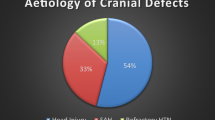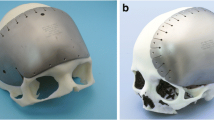Abstract
Objective
Complications following pediatric cranioplasty after craniectomy with either autologous bone flaps or cranial implants are reported to be common, particularly bone flap resorption. However, only sparse data are available regarding cranioplasty strategies, complications, and outcomes. This manuscript describes a Canadian-Dutch multicenter pediatric cohort study with autografts and cranial implant cranioplasties following craniectomies for a variety of indications.
Methods
The study included all children (< 18 years) who underwent craniectomy and subsequent cranioplasty surgeries from 2008 to 2014 (with a minimum of 1-year follow-up) at four academic hospitals with a dedicated pediatric neurosurgical service. Data were collected regarding initial diagnosis, age, time interval between craniectomy and cranioplasty, bone flap storage method, type of cranioplasty for initial procedure (and redo if applicable), and the postoperative outcome including surgical site infection, wound breakdowns, bone flap resorption, and inadequate fit/disfigurement.
Results
Sixty-four patients (46 males, average age 9.7 ± 5.5 years) were eligible for inclusion, with mean follow-up of 82.3 ± 31.2 months after craniectomy. Forty cranioplasties (62.5%) used autologous bone re-implant, 23 (57.5%) of which showed resorption. On average, resorption was documented at 434 days (range 62–2796 days) after reimplantation. In 20 cases, a revision cranioplasty was needed. In 24 of the post-craniectomy cases (37.5%), a cranial implant was used with one of ten different implant types. Implant loosening prompted a complete revision cranioplasty in 2 cases (8.3%). Cranial implants were associated with low morbidity and lower reoperation dates compared to the autologous cranioplasties.
Conclusion
The most prominent finding in this multicenter cohort study was that bone flap resorption in children remains a common and widespread problem following craniectomy. Cranioplasty strategies varied between centers and evolved over time within centers. Cranial implants were associated with low morbidity and low reoperation rates. Still, longer term and prospective multicenter cohort studies are needed to optimize cranioplasty strategies in children after craniectomies.




Similar content being viewed by others
References
Bowers CA, McMullin JH, Brimley C, Etherington L, Siddigi FA, Riva-Cambrin J (2015) Minimizing bone gaps when using custom pediatric cranial implants is associated with implant success. J Neurosurg Pediatr 16:439–444. https://doi.org/10.3171/2015.2.PEDS14536
Bowers CA, Riva-Cambrin J, Hertzler DA 2nd, Walker ML (2013) Risk factors and rates of bone flap resorption in pediatric patients after decompressive craniectomy for traumatic brain injury. J Neurosurg Pediatr 11:526–532. https://doi.org/10.3171/2013.1.PEDS12483
Chao MT, Jiang S, Smith D, DeCesare GE, Cooper GM, Pollack IF, Girotto J, Losee JE (2009) Demineralized bone matrix and resorbable mesh bilaminate cranioplasty: a novel method for reconstruction of large-scale defects in the pediatric calvaria. Plast Reconstr Surg 123:976–982. https://doi.org/10.1097/PRS.0b013e31819ba46f
Choi SH, Levy ML, McComb JG (1998) A method of cranioplasty using coralline hydroxyapatite. Pediatr Neurosurg 29:324–327. https://doi.org/10.1159/000028747
Cohen AJ, Dickerman RD, Schneider SJ (2004) New method of pediatric cranioplasty for skull defect utilizing polylactic acid absorbable plates and carbonated apatite bone cement. J Craniofac Surg 15:469–472
Costantino PD, Chaplin JM, Wolpoe ME, Catalano PJ, Sen C, Bederson JB, Govindaraj S (2000) Applications of fast-setting hydroxyapatite cement: cranioplasty. Otolaryngol Head Neck Surg 123:409–412. https://doi.org/10.1067/mhn.2000.107679
Ducic Y (2002) Titanium mesh and hydroxyapatite cement cranioplasty: a report of 20 cases. J Oral Maxillofac Surg 60:272–276
Eppley BL, Hollier L, Stal S (2003) Hydroxyapatite cranioplasty: II. Clinical experience with a new quick-setting material. J Craniofac Surg 14:209–214
Fiaschi P, Pavanello M, Imperato A, Dallolio V, Accogli A, Capra V, Consales A, Cama A, Piatelli G (2016) Surgical results of cranioplasty with a polymethylmethacrylate customized cranial implanted in pediatric patients: a single-center experience. J Neurosurg Pediatr 17:705–710. https://doi.org/10.3171/2015.10.PEDS15489
Frassanito P, Massimi L, Caldarelli M, Tamburrini G, Di Rocco C (2012) Complications of delayed cranial repair after decompressive craniectomy in children less than 1 year old. Acta Neurochir 154:927–933. https://doi.org/10.1007/s00701-011-1253-5
Frassanito P, Massimi L, Caldarelli M, Tamburrini G, Di Rocco C (2014) Bone flap resorption in infants. J Neurosurg Pediatr 13:243–244. https://doi.org/10.3171/2013.6.PEDS13312
Frassanito P, Massimi L, Tamburrini G, Bianchi F, Nataloni A, Canella V, Caldarelli M (2018) Custom-made hydroxyapatite for cranial repair in a specific pediatric age group (7-13 years old): a multicenter post-marketing surveillance study. Childs Nerv Syst 34:2283–2289. https://doi.org/10.1007/s00381-018-3905-8
Frassanito P, Tamburrini G, Massimi L, Di Rocco C, Nataloni A, Fabbri G, Caldarelli M (2015) Post-marketing surveillance of CustomBone Service implanted in children under 7 years old. Acta Neurochir 157:115–121. https://doi.org/10.1007/s00701-014-2254-y
Frassanito P, Tamburrini G, Massimi L, Peraio S, Caldarelli M, Di Rocco C (2017) Problems of reconstructive cranioplasty after traumatic brain injury in children. Childs Nerv Syst 33:1759–1768. https://doi.org/10.1007/s00381-017-3541-8
Fu KJ, Barr RM, Kerr ML, Shah MN, Fletcher SA, Sandberg DI, Teichgraeber JF, Greives MR (2016) An outcomes comparison between autologous and alloplastic cranioplasty in the pediatric population. J Craniofac Surg 27:593–597. https://doi.org/10.1097/SCS.0000000000002491
Grant GA, Jolley M, Ellenbogen RG, Roberts TS, Gruss JR, Loeser JD (2004) Failure of autologous bone-assisted cranioplasty following decompressive craniectomy in children and adolescents. J Neurosurg 100:163–168. https://doi.org/10.3171/ped.2004.100.2.0163
Josan VA, Sgouros S, Walsh AR, Dover MS, Nishikawa H, Hockley AD (2005) Cranioplasty in children. Childs Nerv Syst 21:200–204. https://doi.org/10.1007/s00381-004-1068-2
Ma IT, Symon MR, Bristol RE, Beals SP, Joganic EF, Adelson PD, Shafron DH, Singh DJ (2018) Outcomes of titanium mesh cranioplasty in pediatric patients. J Craniofac Surg 29:99–104. https://doi.org/10.1097/SCS.0000000000004045
Martin KD, Franz B, Kirsch M, Polanski W, Von der Hagen M, Schackert G, Sobottka SB (2014) Autologous bone flap cranioplasty following decompressive craniectomy is combined with a high complication rate in pediatric traumatic brain injury patients. Acta Neurochir 156:813–824. https://doi.org/10.1007/s00701-014-2021-0
Pang D, Tse HH, Zwienenberg-Lee M, Smith M, Zovickian J (2005) The combined use of hydroxyapatite and bioresorbable plates to repair cranial defects in children. J Neurosurg 102:36–43. https://doi.org/10.3171/ped.2005.102.1.0036
Piedra MP, Thompson EM, Selden NR, Ragel BT, Guillaume DJ (2012) Optimal timing of autologous cranioplasty after decompressive craniectomy in children. J Neurosurg Pediatr 10:268–272. https://doi.org/10.3171/2012.6.PEDS1268
Rocque BG, Agee BS, Thompson EM, Piedra M, Baird LC, Selden NR, Greene S, Deibert CP, Hankinson TC, Lew SM, Iskandar BJ, Bragg TM, Frim D, Grant G, Gupta N, Auguste KI, Nikas DC, Vassilyadi M, Muh CR, Wetjen NM, Lam SK (2018) Complications following pediatric cranioplasty after decompressive craniectomy: a multicentre retrospective study. J Neurosurg Pediatr 8:1–8. https://doi.org/10.3171/2018.3.PEDS17234
Rocque BG, Amancherla K, Lew SM, Lam S (2013) Outcomes of cranioplasty following decompressive craniectomy in the pediatric population. J Neurosurg Pediatr 12:120–125. https://doi.org/10.3171/2013.4.PEDS12605
Taggard DA, Menezes AH (2001) Successful use of rib grafts for cranioplasty in children. Pediatr Neurosurg 34:149–155. https://doi.org/10.1159/000056010
Waqas M, Ujjan B, Hadi YB, Najmuddin LAA, Khalid S, Bari ME, Bhatti UF (2017) Cranioplasty after craniectomy in a pediatric population: single-center experience from a developing country. Pediatr Neurosurg 52:77–79. https://doi.org/10.1159/000452808
Williams L, Fan K, Bentley R (2016) Titanium cranioplasty in children and adolescents. J Craniomaxillofac Surg 44:789–794. https://doi.org/10.1016/j.jcms.2016.03.010
Acknowledgements
KJM is supported by the Van Wagenen Foundation.
Author information
Authors and Affiliations
Corresponding author
Ethics declarations
Conflict of interest
With the submission of this manuscript, I would like to state that the authors report no conflict of interest concerning the materials and methods used or the findings specified in this paper. Furthermore, the authors declare that this study was performed in accordance to the research ethical guidelines.
Additional information
Publisher’s note
Springer Nature remains neutral with regard to jurisdictional claims in published maps and institutional affiliations.
Rights and permissions
About this article
Cite this article
Klieverik, V.M., Miller, K.J., Han, K.S. et al. Cranioplasties following craniectomies in children—a multicenter, retrospective cohort study. Childs Nerv Syst 35, 1473–1480 (2019). https://doi.org/10.1007/s00381-018-4024-2
Received:
Accepted:
Published:
Issue Date:
DOI: https://doi.org/10.1007/s00381-018-4024-2




